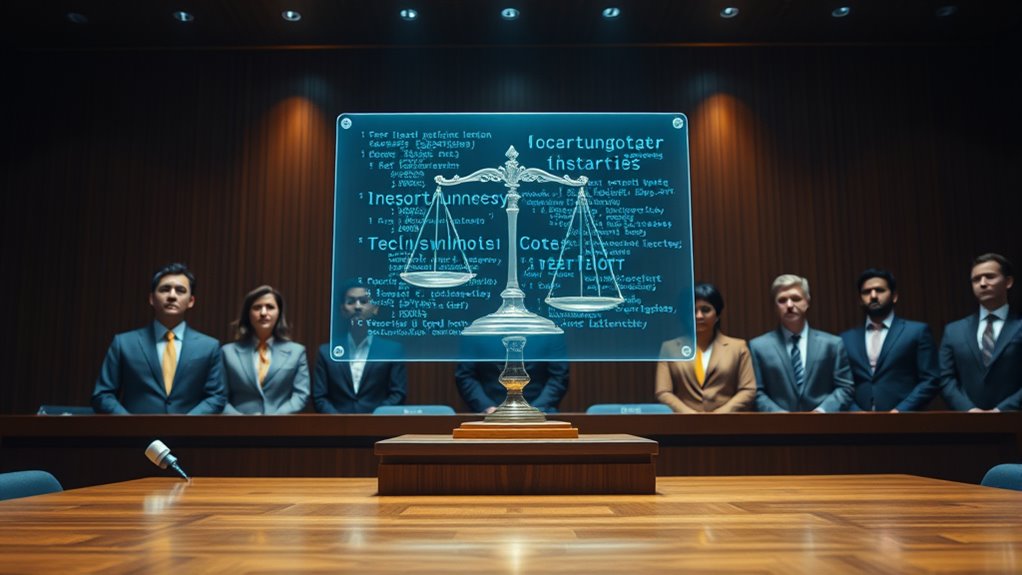When algorithms make decisions, responsibility varies based on legal frameworks, which differ by region. In the EU, operators face strict liability, while the US lacks unified rules, often leaving accountability unclear. Intellectual property rights depend on jurisdiction and human involvement. Ethical issues like bias and opacity also influence accountability. If you want to understand how liability is assigned and what risks you face, keep exploring these legal and ethical considerations.
Key Takeaways
- Liability varies by jurisdiction, with the EU imposing strict liability and the U.S. lacking a unified approach.
- Human operators and developers are generally responsible for AI decisions, especially under strict liability regimes.
- Legal responsibility depends on whether the AI acts autonomously or under human oversight.
- Contractual agreements often clarify ownership and liability among AI providers, users, and owners.
- International legal diversity complicates establishing a consistent framework for accountability in AI decision-making.
Legal Frameworks for AI Liability and Accountability

Legal frameworks for AI liability and accountability vary considerably across jurisdictions, reflecting different approaches to managing the risks posed by autonomous systems. In the EU, a risk-based framework classifies AI by danger level, imposing stricter rules on high-risk systems. Operators of these systems face strict liability, with requirements for insurance and compensation funds if fault isn’t clear. The U.S. lacks a unified federal approach; instead, states experiment with diverse models like regulatory sandboxes and “right to compute” laws, leading to fragmented liability regimes. Japan integrates corporate law and AI governance by assigning rights and obligations to providers through specific business structures. These differences profoundly influence how companies manage AI risks, shape ethical standards, and affect international cooperation, highlighting the ongoing challenge of creating consistent, effective legal accountability for AI systems. Legal approaches vary significantly, which creates challenges for international collaboration and the development of universally applicable standards. Additionally, ongoing legal developments aim to better define AI liability and establish clearer guidelines for stakeholders involved in deploying such technologies.
Intellectual Property Rights in AI-Generated Content

As AI systems increasingly generate creative works, questions about their legal status under copyright law have become more pressing. In the U.S., works created solely by AI can’t be copyrighted because human authorship is required, and courts like the 2023 D.C. District Court confirm only humans qualify as authors. The U.S. Copyright Office echoes this stance, refusing to register AI-only works. Elsewhere, countries like China recognize copyright for AI-generated images if users exert creative control. Some nations, including the UK and India, protect “computer-generated works” without needing human input, creating a patchwork of protections worldwide. Since AI lacks legal personality, ownership rights are debated among owners, developers, and users, often clarified through contracts. This uncertainty complicates rights management and fuels disputes over AI-produced content. Understanding appliance maintenance plans and their coverage can help mitigate issues related to faulty or misused AI-powered appliances.
Ethical and Bias Considerations in Automated Decision-Making

Have you ever wondered how transparent or understandable AI decision-making really is? Often, AI systems operate as a “black box,” making it hard to see how specific outcomes are reached. This opacity can hide biases or unfair decisions, making accountability difficult. Transparency is essential for building trust, but revealing too much can conflict with privacy and security. Regular audits and impact assessments help guarantee AI aligns with ethical and legal standards. Bias and fairness are also major concerns; AI can unintentionally reinforce societal inequalities if trained on non-representative data or left unchecked. Addressing these issues requires ongoing evaluation, expert collaboration, and strong data governance. Understanding bias and fairness is crucial for developing responsible AI systems. Without these efforts, automated decisions risk perpetuating discrimination and undermining ethical principles in critical areas like employment, healthcare, and justice.
Regulatory Trends and Compliance for AI Deployment

Regulatory trends surrounding AI deployment are rapidly shaping how organizations develop and implement these systems. Governments and international bodies are enacting legislation focused on transparency, accountability, and security, especially in sensitive sectors. In the U.S., the AI Research Innovation and Accountability Act proposes mandatory testing standards for high-risk AI and requires companies to report on transparency practices. Consumer privacy laws now grant individuals rights to opt out of algorithmic decisions in critical areas like credit and employment. Efforts to create centralized oversight face resistance from states wary of losing authority, while sector-specific guidelines are emerging through organizations like NIST. Staying compliant means continuously updating policies, managing operational challenges, and ensuring that AI systems meet evolving legal standards to avoid penalties and reputational damage. Additionally, understanding projector technology can help organizations better assess and implement AI systems with visual data processing capabilities.
Navigating Litigation Risks and Risk Management Strategies

Managing litigation risks in AI deployment requires organizations to proactively identify and mitigate potential legal pitfalls. You need to understand common risks like data privacy breaches, bias in hiring tools, cybersecurity threats, and IP disputes. Implement strategies such as extensive governance, privacy policy compliance, and thorough documentation. Regularly assess AI tools for potential liabilities and ensure cybersecurity measures are robust. Consider the following strategies:
| Strategy | Focus Area | Action |
|---|---|---|
| Proactive Governance | Risk Management | Develop clear policies and oversight mechanisms |
| Privacy & Consent | Data Privacy | Obtain explicit consent and document data use |
| Security Measures | Cybersecurity | Implement strong defense protocols |
| Liability Assessment | AI Tool Usage | Review indemnification and liability clauses |
These steps help reduce legal exposure and protect your organization. Implementing comprehensive risk assessments can further identify vulnerabilities before they escalate. Additionally, understanding the cultural perspectives surrounding AI decisions can enhance compliance and ethical standards.
Frequently Asked Questions
How Do Current Laws Define Ai’s Legal Personhood or Rights?
Current laws don’t define AI as a legal person or grant it rights. You’ll find that courts mainly hold humans or corporations responsible for AI’s actions, not AI itself. While some debate exists about future recognition, no jurisdiction currently treats AI as a legal entity with rights or duties. Instead, liability stays with the programmers, owners, or users, emphasizing that AI lacks the essential qualities needed for legal personhood today.
Who Owns Copyright on Ai-Created Artistic or Literary Works?
You don’t automatically own copyright on AI-created works if the AI produces them independently. If you substantially shape or modify the output with your human creativity, you may claim ownership. Otherwise, the rights typically belong to the AI developer or the user who provided the input, depending on terms of service. Clarifying ownership depends on your level of input, the nature of the work, and applicable legal standards.
What Specific Ethical Standards Are Legally Required for AI Systems?
You must guarantee your AI systems meet legal ethical standards like transparency, privacy, fairness, and bias mitigation. You’re responsible for clearly informing clients about AI’s role, risks, and limitations. You need to maintain strict data confidentiality, follow privacy laws, and implement privacy-by-design. Additionally, you must conduct impact assessments to identify biases, prevent discrimination, and establish accountability processes. Staying compliant with these standards helps uphold legal and ethical integrity in your AI applications.
How Can Organizations Ensure Ongoing AI Compliance With International Laws?
Think of AI compliance as steering a ship through ever-changing waters. You must establish clear governance policies aligned with international laws like the EU AI Act and ISO standards, continuously monitor performance, and update risk assessments. Use automated tools for real-time oversight, conduct regular audits, and adapt to new legal developments globally. By staying vigilant and proactive, you guarantee your AI systems remain trustworthy, lawful, and ethically sound across all jurisdictions.
What Legal Recourse Exists if AI Causes Harm Without Human Oversight?
If AI causes harm without human oversight, you can pursue legal action through medical malpractice claims, civil lawsuits, or regulatory complaints. Victims might sue for negligence or product defects, especially if oversight was lacking or the system was faulty. You can also participate in class actions or file insurance claims. However, since liability is complex and laws are evolving, holding parties accountable often depends on demonstrating negligence or failure to follow safety standards.
Conclusion
As you navigate the world of AI, think of yourself as the captain steering a ship through uncharted waters. The currents of liability, ethical dilemmas, and regulation are ever-changing. By understanding and respecting these forces, you can avoid treacherous storms and chart a course toward responsible innovation. Remember, in this vast ocean of algorithms, your vigilance and integrity are the lighthouse guiding you safely to shore.









